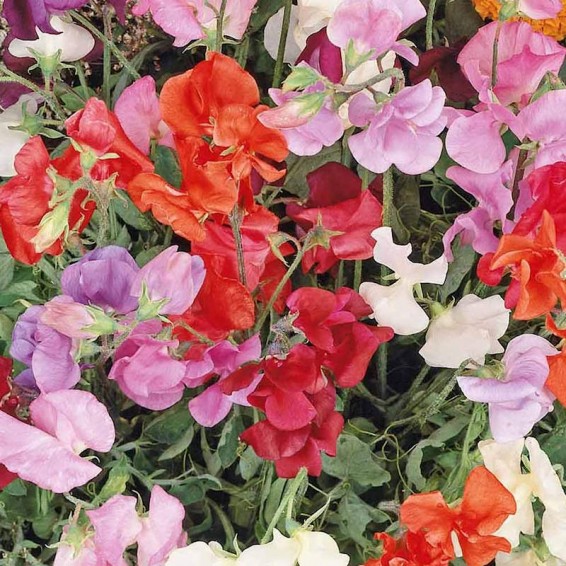Knee High Sweet Pea Seed Mix
- HOW TO GROW
- FAST FACTS
- REVIEWS
HOW TO GROW
Sowing: To soften the hard coating of these seeds, soak them for several hours or overnight in warm water before planting. Most of the seeds should have softened and begun to swell, but if a few remain hard make a slight nick in the seed coat with a sharp knife. In climates with mild winters, these prepared seeds can be sown in the fall to bring the earliest spring blooms. Otherwise, they should be planted in spring as soon as the ground can be worked; light frosts will not be harmful, though the seeds require at least 55 degrees F to germinate. Plant the seeds just under the surface and keep the soil lightly moist until germination. Seeds started indoors should be prepared in the same way, but planted in groups of three in individual peat pots and given plenty of sunlight.
Growing: As the seedlings develop, pinch off the top set of leaves occasionally to encourage branching. Keep in mind that pests such as birds and slugs can damage the young plants. Both seedlings and mature plants need regular watering for best growth; several applications of fertilizer will also bring these plants to their full potential. A layer of mulch will help conserve moisture as well as controlling weeds. This bush-type sweet pea is ideal for hanging baskets, containers, and windowboxes.
Harvesting: Cut these flowers early in the morning, choosing stems with the lowest blossom just beginning to open. Place in water immediately, stripping the leaves that will fall below the surface. Pick the blossoms often, since this encourages more to grow.
Seed Saving: After the faded blossoms fall from the plant, bean-like pods will develop. When they turn from green to a light brown color, pick them from the plant and spread them out to dry away from direct sunlight. When they have dried, split them to remove the seeds; spread the seeds out to dry completely. Store the dried seeds in a cool, dry place.
FAST FACTS
Latin Name: Lathyrus odoratus
Species Origin: Introduced US Flower
Type: Garden Flowers
Life Cycle: Annual
USDA Zones: 1, 2, 3, 4, 5, 6, 7, 8, 9, 10, 11, 12
US Regions: California, Mountain, Arid/Desert, Plains/Texas, Midwest, Northern, Northeast, Southeast
Seeds per Ounce: 300
Stratification: No Stratification
Germination Ease: No Stratification
Sunlight: Full Sun
Height: 30 Inches
Color: Mixed, White, Pink, Red, Purple
Bloom Season: Blooms Early Summer, Blooms Late Summer
Uses: Aromatic, Cut Flowers
Raymond
I love the foil packets your seeds will hold up for planting the next year if u don't use all of them plus fast service
DESCRIPTION
HOW TO GROW
Sowing: To soften the hard coating of these seeds, soak them for several hours or overnight in warm water before planting. Most of the seeds should have softened and begun to swell, but if a few remain hard make a slight nick in the seed coat with a sharp knife. In climates with mild winters, these prepared seeds can be sown in the fall to bring the earliest spring blooms. Otherwise, they should be planted in spring as soon as the ground can be worked; light frosts will not be harmful, though the seeds require at least 55 degrees F to germinate. Plant the seeds just under the surface and keep the soil lightly moist until germination. Seeds started indoors should be prepared in the same way, but planted in groups of three in individual peat pots and given plenty of sunlight.
Growing: As the seedlings develop, pinch off the top set of leaves occasionally to encourage branching. Keep in mind that pests such as birds and slugs can damage the young plants. Both seedlings and mature plants need regular watering for best growth; several applications of fertilizer will also bring these plants to their full potential. A layer of mulch will help conserve moisture as well as controlling weeds. This bush-type sweet pea is ideal for hanging baskets, containers, and windowboxes.
Harvesting: Cut these flowers early in the morning, choosing stems with the lowest blossom just beginning to open. Place in water immediately, stripping the leaves that will fall below the surface. Pick the blossoms often, since this encourages more to grow.
Seed Saving: After the faded blossoms fall from the plant, bean-like pods will develop. When they turn from green to a light brown color, pick them from the plant and spread them out to dry away from direct sunlight. When they have dried, split them to remove the seeds; spread the seeds out to dry completely. Store the dried seeds in a cool, dry place.
FAST FACTS
Latin Name: Lathyrus odoratus
Species Origin: Introduced US Flower
Type: Garden Flowers
Life Cycle: Annual
USDA Zones: 1, 2, 3, 4, 5, 6, 7, 8, 9, 10, 11, 12
US Regions: California, Mountain, Arid/Desert, Plains/Texas, Midwest, Northern, Northeast, Southeast
Seeds per Ounce: 300
Stratification: No Stratification
Germination Ease: No Stratification
Sunlight: Full Sun
Height: 30 Inches
Color: Mixed, White, Pink, Red, Purple
Bloom Season: Blooms Early Summer, Blooms Late Summer
Uses: Aromatic, Cut Flowers
Reviews
Review
Raymond
I love the foil packets your seeds will hold up for planting the next year if u don't use all of them plus fast service




